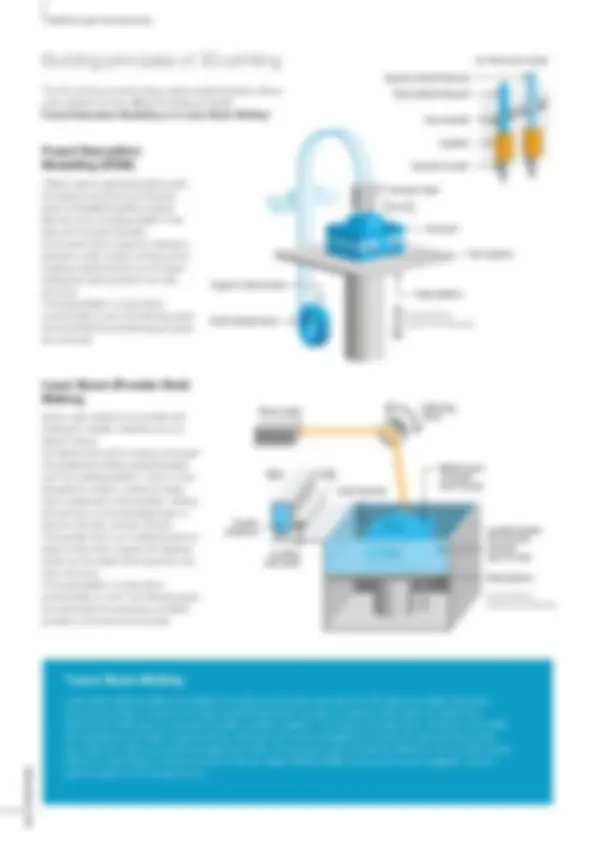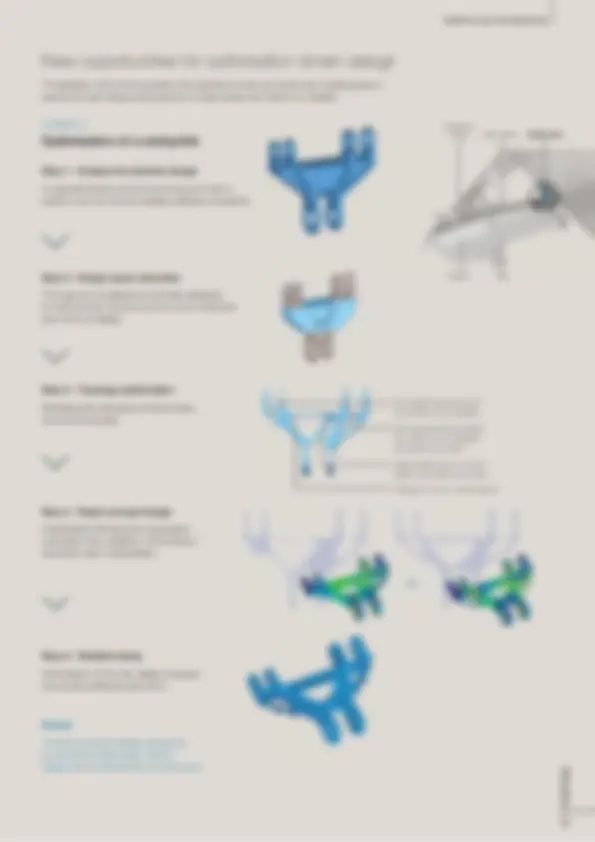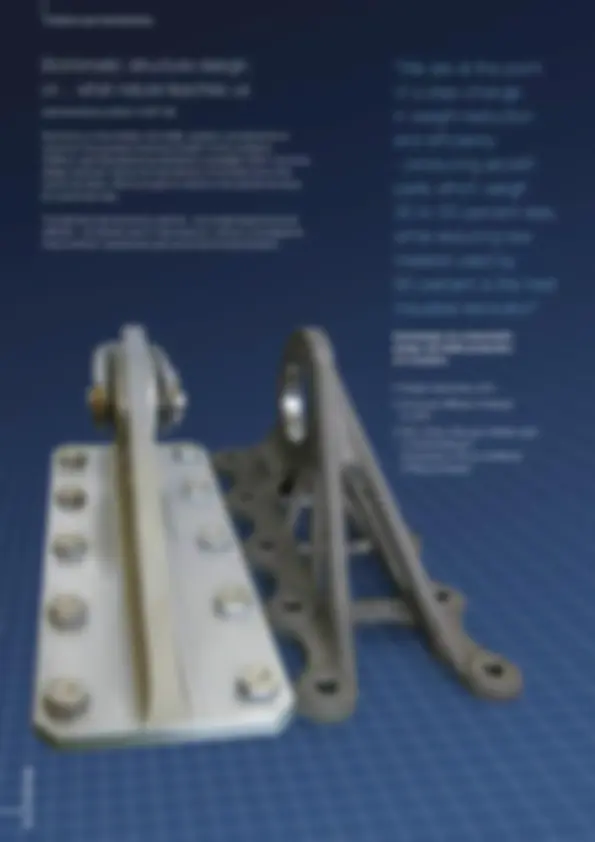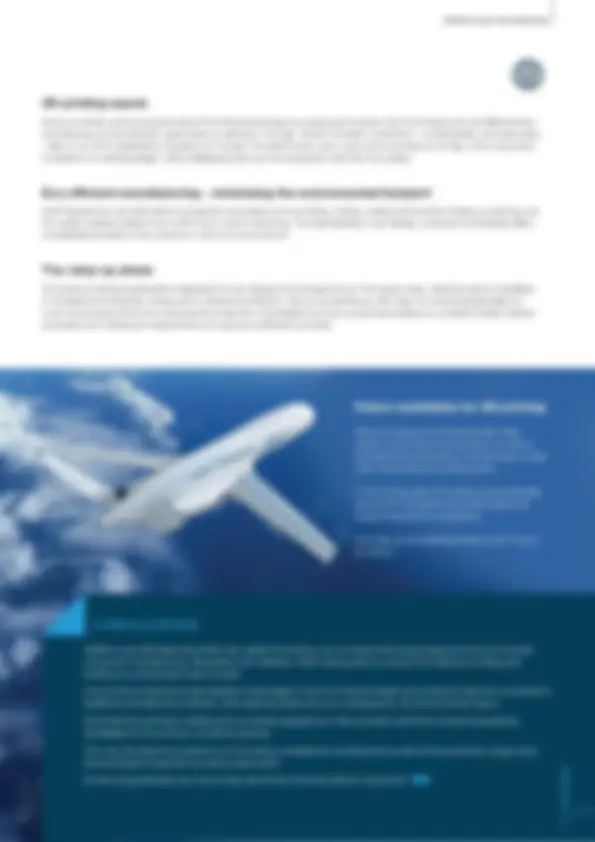






Study with the several resources on Docsity

Earn points by helping other students or get them with a premium plan


Prepare for your exams
Study with the several resources on Docsity

Earn points to download
Earn points by helping other students or get them with a premium plan
Community
Ask the community for help and clear up your study doubts
Discover the best universities in your country according to Docsity users
Free resources
Download our free guides on studying techniques, anxiety management strategies, and thesis advice from Docsity tutors
Airbus' implementation of Additive Layer Manufacturing (ALM), also known as 3D-printing, to produce lighter, more efficient, and cost-effective aircraft parts. The technology allows for the production of complex components directly from Computer-Aided Design (CAD) information, reducing lead times and material usage while minimizing the environmental footprint.
What you will learn
Typology: Study notes
1 / 8

This page cannot be seen from the preview
Don't miss anything!





Printing the future with revolutionary
Article by Peter SANDER Emerging Technologies & Concepts AIRBUS Peter.Sander@airbus.com
An innovative technology shaping the future of aviation Across the Airbus Group, numerous projects are speeding-up the development of Additive Layer Manufacturing (ALM), also known as 3D-printing, to produce prototypes and components, potentially delivering more cost-effective and lighter aircraft parts. 3D-printing technology can also improve production efficiency while avoiding shortages of components on assembly lines.
The first metal parts produced with this method (figures 1 & 2) are beginning to appear on a range of Airbus aircraft - from the latest A350 to the A300/A310 Family aircraft.
A quick overview about the 3D-printing technique indicates:
“This game-changing
technology
decreases the total
energy used in
production by up
to 90 percent
compared with
traditional methods”.
Figure 2: The flight crew rest compartment bracket installed on A
Figure 1: Belt panel on an A cabin crew seat
The technology process Instead of producing a part by milling a solid block of material, Additive Layer Manufacturing (ALM) “grows” parts and products using base materials such as aluminium, titanium, stainless steel and plastics. Adding thin layers of material in incremental stages, generates parts, enabling complex components to be produced directly from Computer-Aided Design (CAD) information sent to the 3D-printer. At the same time as the material layers are built-up, so is a layer of supporting material for the following layers (see building principles overleaf).
Materials of interest The range of materials used encompasses high performance plastics such as Polyetherimide (PEI), PEAK/PEK (polymer), FullCure (acrylic-based photopolymer), Polyamide, Accura and Greystone, to high performance metallic alloys including Titanium (Ti), Aluminium (Al), Maraging steel as well as graded materials. In industries outside aviation, materials used to make free-form shapes can include concrete and glass, and even edible ingredients such as chocolate.
For the A350 aircraft, Airbus has produced and incorporated a variety of 3D-printed plastic and metal brackets, whose material and structural properties have been tested and duly certified.
The flexibility of 3D-printing widens the potential of what can be formed, building parts in exactly the right shape and proportion to take stress only where it is needed.
Step 1 - Analyse the baseline design
to evaluate exactly what functions the part has to perform such as volume needed, stiffness constraints.
New opportunities for optimisation driven design
Optimisation of a swing link
Slim supporting ribs at lug A with central cut-out between Slim supporting ribs at lug B with central cut-out between and small corner webs Tapered stiffening rib in centre section with small corner webs Triangular cut-out in centre section
Spoiler Flap
Gear beam Swing link
Cantilever fitting
Result:
The final swing link design carried out by the Airbus Optimisation Centre weighs less to fulfil exactly the same task.
Step 2 - Design space allocation
The lugs are considered as optimally designed for their function and as such are not an important part of the re-design.
Step 3 - Topology optimisation
Revealing the load paths and formulate structural principles.
Step 4 - Rapid concept design
Interpretation following the topological load paths then validation of the tension carried for each interpretation.
Step 5 - Detailed sizing
Optimisation of the new design proposal, structurally perfecting each form.
or
Biomimetic structure design,
or... what nature teaches us
(see biomimicry article in FAST 49)
Biomimicry is the imitation of models, systems, and elements of nature for the purpose of solving complex human problems. Additive Layer Manufacturing represents a paradigm shift in structure design because it allows the reproduction of complex forms that nature has taken millions of years to evolve to the optimal structure for a particular task.
The lightness that biomimicry permits - for at least equal structural stiffness - will directly result in less fuel burn, and as a consequence reduce airlines’ operational costs and environmental footprint.
“We are at the point
of a step-change
in weight reduction
and efficiency
parts which weigh
30 to 55 percent less,
while reducing raw
material used by
90 percent is the next
industrial revolution”.
Advantages of a biomimetic design and ALM production of a bracket:
Convetional machining ALM speedline
reaction time lead time cost weight
100 90 80 70 60 50 40 30 20 10
Benefits of 3D-printing 3D-printing makes it simpler to produce very complex shapes, therefore, parts designed for and manufactured by ALM can have a natural and topologically optimised shape, which would be impossible if producing them from a solid block of material. Such parts are significantly lighter, faster to produce and ultimately much less expensive than conventional ones.
ALM in the assembly line: print and go Beyond its use to build parts that are already flying, Airbus Group is looking into using ALM technology to avoid shortages during the manufacturing process.
Conventional machining compared with the ALM speedline
C O N C L U S I O N
Additive Layer Manufacturing (ALM), also called 3D-printing, is an innovative technology shaping the future of aircraft component manufacturing. Harnessing CAD software, ALM is being used to construct 3D objects by melting and building up a solid product layer by layer. Components produced provide significant advantages in terms of reduced weight and production lead time compared to traditional manufacturing methods, while reducing waste and, as a consequence, the environmental impact. 3D-printed airworthiness certified parts are already appearing on Airbus aircraft, and the list of parts proposed as candidates for 3D-printing is constantly growing. This new manufacturing method is not only being considered for aircraft parts but also for the production of jigs, tools, Ground Support Equipment as well as spare parts. As technology develops we may one day see the first entire aircraft built using ALM.
Future candidates for 3D-printing
Airbus is looking at the entire aircraft: cabin, system and structural components, as well as manufacturing and tooling. It will also play a major role in the production of spare parts.
In the coming years 3D-printing could potentially account for thousands of aircraft and ground support equipment components.
Each day we are stepping closer to the “Future by Airbus”.
3D-printing spares
Airbus is actively working towards using 3D printing technology as a spare parts solution due to the ease and cost effectiveness of producing out-of-production spare parts on-demand. This year, the first “printed” component – a small plastic crew seat panel
Eco-efficient manufacturing - minimising the environmental footprint
ALM represents a new alternative to production processes such as milling, melting, casting and precision forging, producing only 5% waste material instead of up to 95% from current machining. The high flexibility in part design, production and testing offers considerable benefits to the customer in terms of cost and time.
The ramp-up phase
3D-printing is being progressively integrated into new design and manufacturing in the supply chain, starting small but steadfast in the fields of prototyping, tooling and on-demand production. Airbus has teamed up with major 3D-printing stakeholders to cover the process end-to-end, ensuring the production of certifiable structural components based on consistent tested material properties and meeting the requirements of a rigorous certification process.
Airbus Concept Plane